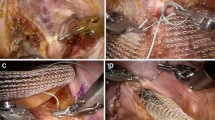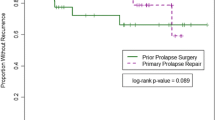Abstract
Purpose
Many different operations have been proposed for treating rectal prolapse, with varying recurrence rates and functional outcome. The main purpose of this study was to assess long-term results of surgery for prolapse of the rectum.
Methods
We carried out a retrospective study to evaluate changing trends in surgical strategies and outcome in all patients treated in our hospital over 19 years.
Results
Ninety-three patients were operated and 30 (32%) experienced recurrence of external prolapse during a median (range) follow-up time of 82 (2–231) months. There were 37 reoperations for recurrence, bringing the total number of operations to 130.
From 1998 to 2010, laparoscopic posterior suture rectopexy was the preferred abdominal procedure with Delorme’s operation as the perineal alternative. Observed recurrence rates were 15/49 (31%) and 8/15 (53%) during a median observation time of 84 and 9 months, respectively.
From 2011 to 2017, these procedures were replaced by ventral mesh rectopexy and Altemeier’s rectosigmoidectomy. The observed recurrence rate for ventral mesh rectopexy was 3/22 (14%) during a median observation time of 29 months. The 30-day mortality rate was 3% and complication rate 14%.
Conclusions
The recurrence rates were high after all procedures, with no significant difference between posterior suture rectopexy and ventral mesh rectopexy, but the short observation time for the latter procedure is a limitation of the study. Both procedures had low complication rates, and ventral mesh rectopexy had no mortality.



Similar content being viewed by others
References
Miles WE (1933) Rectosigmoidectomy as method of treatment for procidentia recti. Proc R Soc Med 26:1445
Karasick S, Spettell CM (1999) Defecography: does parity play a role in the development of rectal prolapse? Eur Radiol 9:450–453
Hampton BS (2009) Pelvic organ prolapse, Medicine and Health Rhode Island; Providence 92.1 (Jan 2009): 5–9
Elneil S (2009) Complex pelvic floor failure and associated problems. Best Pract Res Clin Gastroenterol 23:555–573
Lohsiriwat V (2016) Anorectal emergencies. World J Gastroenterol 22(26):5867–5878
Pares D, Vial M, Grande L (2009 Jun) An alternative management for high-risk patients with rectal prolapse. Color Dis 11(5):531–532
Madiba TE, Baig MK, Wexner SD (2005) Surgical Management of Rectal Prolapse. Arch Surg 140:63–73
Harmston C, Jones O (2011) The evolution of laparoscopic surgery for rectal prolapse. Rev Int J Surg 9:370–373
Lechaux D, Trebuchet G, Siproudhis L, Campion JP (2005) Laparoscopic rectopexy for full-thickness rectal prolapse. Surg Endosc 19:514–518
Nunoo-Mensah JW, Efron JE, Young-Fadok TM (2007) Laparoscopic rectopexy. Surg Endosc 21:325–326
Heah SM, Hartley JE, Hurley J, Duthie GS, Monson JRT (2000) Laparoscopic suture rectopexy without resection is effective treatment for full-thickness rectal prolapse. Dis Colon Rectum 43:638–643
Byrne CM, Smith SR, Solomon MJ, Young JM, Eyers AA, Young CJ (2008) Long-term functional outcomes after laparoscopic and open rectopexy for the treatment of rectal prolapse. Dis Colon Rectum 51:1597–1604
Dindo D, Demartines N, Clavien P-A (2004) Classification of surgical complications. Ann Surg 240(2):205–213
DiGiurio G, Ignatovic D, Brogger J, Bergamaschi R (2006) How accurate are published recurrence rates after rectal prolapse surgery? A meta-analysis of individual patient data. Am J Surg 191:773–778
Foppa C, Martinek L, Arnaud JP, Bergamaschi R (2014) Ten-year follow up after laparoscopic suture rectopexy for full-thickness rectal prolapse. Color Dis 16(10):809–814
D’Hoore A, Cadoni R, Penninckx F (2004) Long-term outcome of laparoscopic ventral rectopexy for total rectal prolapse. Br J Surg 91(11):1500–1505
Auguste T, Dubreuil A, Bost R, Bonaz B, Faucheron JL (2006) Technical and functional results after laparoscopic rectopexy to the promontery for complete rectal prolapse. Gastroenterol Clin Biol 30:659–663
Faucheron JL, Voirin D, Riboud R, Waroquet PA, Noel J (2012) Laparoscopic anterior rectopexy to the promontory for full-thickness rectal prolapse in 175 consecutive patients: short- and long-term follow-up. Dis Colon Rectum 55(6):660–665
Deen KI, Grant E, Billingham C, Keighley MR (1994) Abdominal resection rectopexy with pelvic floor repair versus perineal rectosigmoidectomy and pelvic floor repair for full-thickness rectal prolapse. Br J Surg 81(2):302–304
Watts AMI, Thompson MR (2000) Evaluation of Delorme’s procedure as a treatment for full-thickness rectal prolapse. Br J Surg 87:218–222
Marchal F, Bresler L, Ayav A, Zarnegar R, Brunaud L, Duchamp C, Boissel P (2005) Long-term results of Delorme’s procedure and Orr-Loygue rectopexy to treat complete rectal prolapse. Dis Colon Rectum 48:1785–1790
Elagili F, Gurland B, Liu X, Church J, Ozuner G (2015) Comparing perineal repairs for rectal prolapse: Delorme versus Altemeier. Tech Coloproctol 19:521–525
Altemeier WA, Culbertson WR, Schowengerdt C, Hunt J (1971) Nineteen years` experience with the one-stage perineal repair of rectal prolapse. Ann Surg June 173(6)
Alam NN, Narang SK, Kőkerling F, Daniels IR, Smart NJ (2015) Rectopexy for rectal prolapse. Rev Front Surg 2:Article 54
Consten ECJ, Van Iersel JJ, Verheijen PM, Broeders IAMJ, Wolthuis AM, D'Hoore A (2015) Long-term outcome after laparoscopic ventral mesh rectopexy. Ann Surg 262:742–748
Urogynecologic surgical mesh: update on the safety and Effectiveness of transvaginal placement for pelvic organ prolapse. FDA Public Health Notification, October 2008
Evans C, Stevenson AR, Sileri P, Mercer-Jones MA, Dixon AR, Cunningham C, Jones OM, Lindsey I (2015) A multicenter collaboration to assess the safety of laparoscopic ventral Rectopexy. Dis Colon Rectum 58(8):799–807
Mäkelä-Kaikkonen J, Rautio T, Kairaluoma M, Carpelan-Holmström M, Kössi J, Rautio A, Ohtonen P, Mäkelä J (2018) Does ventral rectopexy improve pelvic floor function in the long term? Dis Colon Rectum 61:230–238
Bjerke T, Mynster T (2018) One decade of rectal prolapse surgery: a national study. Int J Color Dis 33(3):299–304. https://doi.org/10.1007/s00384-017-2944-z
Heemskerk J, De Hoog DENM, Van Gemert WG, Baeten CGMI, Greve JWM, Bouvy ND (2007) Robot-assisted vs. conventional laparoscopic rectopexy for rectal prolapse: a comparative study on costs and time. Dis Colon Rectum 50(11):1825–1830
Van Iersel JJ, Paulides TJC, Verheijen PM, Lumley JW, Broeders IAMJ, Consten ECJ (2016) Current status of laparoscopic and robotic ventral mesh rectopexy for external and internal rectal prolapse. World J Gastroenterol 22(21):4977–4987
Tou S, Brown SR, Nelson RL (2015) Surgery for complete (full-thickness) rectal prolapse in adults. Cochrane Database Syst Rev (11):CD001758
Senapati A, Gray RG, Middleton LJ, Harding J, Hills RK, Armitage NC, Buckly L, Northover JM (2013) PROSPER: a randomised comparison of surgical treatments for rectal prolapse. Color Dis 15(7):858–868
Rothenhoefer S, Herrle F, Herold A, Joos A, Bussen D, Kieser M, Schiller P, Klose C, Seiler CM, Kienle P, Post S (2012) DeloRes trial: study protocol for a randomized trial comparing two standardized surgical approaches in rectal prolapse – Delorme’s procedure versus resection rectopexy. Trials 2012 13:155
Author information
Authors and Affiliations
Contributions
Authorship D. G. and W.A. W. initiator of project, substantial involvement in data acquisition, interpretation of data, drafting of article and approval of version to be published. Accountable for all aspects of the work; A. N. Substantial contribution to conception and design, statistical analysis and interpretation of data, structuring of article, critical revision and approval of version to be published. Accountable for all aspects of the work.
Corresponding author
Ethics declarations
All procedures were performed in accordance with the ethical standards of the institutional research committee and with the 1964 Helsinki declaration and its later amendments or comparable ethical standards. For this type of study formal consent is not required.
Approval of ethics and study protocol was obtained from the Hospital Research Committee and the Data Protection Official for Research.
Conflict of interest
The authors declare that they have no conflict of interest.
Rights and permissions
About this article
Cite this article
Gleditsch, D., Wexels, W.A. & Nesbakken, A. Surgical options and trends in treating rectal prolapse: long-term results in a 19-year follow-up study. Langenbecks Arch Surg 403, 991–998 (2018). https://doi.org/10.1007/s00423-018-1728-4
Received:
Accepted:
Published:
Issue Date:
DOI: https://doi.org/10.1007/s00423-018-1728-4




